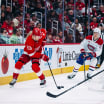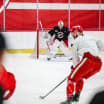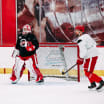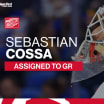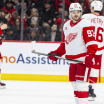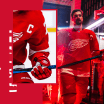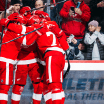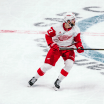The team bus of the Windsor Spitfires was winding its way home along the highway following a game in Kingston. As some of the players moved around the bus shirtless, they flexed, obviously proud of their athletic physiques.
Tom Webster, Windsor's coach at the time, could only chuckle at their misplaced pride.
On the Wings of Tomorrow
Wings prospects discover there's a lot to learn in becoming an NHL player; Mastrosimone scores; Gylander unbeaten and more in the October prospects report
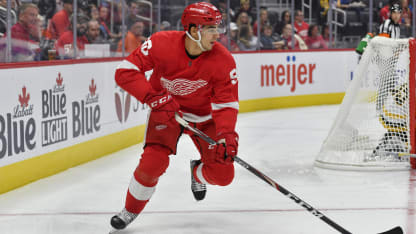
© Icon Sportswire/Getty Images
By
Bob Duff @asktheduffer / Special to DetroitRedWings.com
"These guys don't even know what being in shape is," Webster suggested. "But they'll find out."
Webster played 11 pro seasons, including 84 games with the Detroit Red Wings. He was an NHL head coach for an additional four seasons, a coaching career he launched with two seasons in charge of Detroit's AHL farm club in Adirondack from 1979-81. He was Bobby Orr's teammate, Gordie Howe's roommate and Wayne Gretzky's coach.
So yeah, he'd seen a lot.
The message Webster gave those kids on that bus all those years ago remains the same one delivered today to young players seeking to make the NHL grade.
You've all got a lot to learn.
"It's tough," Red Wings center Dylan Larkin remembered of his first taste of NHL life. "It's a different level from what you've played at. It's intense every second of the game.
"There's no free space, free time. You have to create everything for yourself as a centerman."
Larkin is among a unique and extremely rare group of Red Wings. He made the jump directly into the NHL without requirement of minor-league seasoning.
Ted Lindsay, Red Kelly and current Wings executive vice president and general manager Steve Yzerman, all of them Hall of Famers, are others who were able to successfully take this leap.
Even Howe, Mr. Hockey himself, spent a year in the minors before cracking the Detroit lineup.
Right-winger Anthony Mantha, Detroit's top pick in the 2013 NHL Entry Draft, toiled 132 games with Grand Rapids of the AHL, honing his craft before he made it for good as an NHLer. Right wing Filip Zadina, selected sixth overall in the 2018 Draft, is still with Grand Rapids. So is center Joe Veleno, the 30th player chosen in the 2018 Draft.
That doesn't mean any of them are poor players. It simply exemplifies the daunting challenge all prospects face in order to make the NHL grade.
"It's a hard league to play in and you've got to work hard for every little bit of it," Veleno said. "You're trying to earn a spot on a team, take someone's job."
Hockey is no longer merely something they do. It's their livelihood. Everything they do during the course of a day -- from nutrition, to rest, to the off-ice habits and hobbies -- must be done while keeping foremost in their minds how it will impact their hockey.
"I guess that's what it comes down to now," Veleno said. "You're trying to play in the NHL. You want to play in the best league in the world, so you've got to work for it. I've got to get better every year."
In their bid to stand out, to try and get noticed, often prospects will mistakenly think that it's all about numbers they accumulate.
"In juniors, at the start of the year when I first got back (last season), I was cheating a lot on offense," Veleno admitted. "I really wanted to put up points, but I felt it wasn't working so well, so I focused a lot on defense.
"That actually led to more offense for me and just the type of game I play, my work ethic and my speed are my two biggest attributes, so without that, I don't have as much success."
Convincing young players that the way to get noticed isn't by posting flashy digits but instead by displaying that they can play a responsible game and in turn, earn the trust of their coach, is often a difficult message to get through to heartbroken kids who've just been told -- often for the first time in their hockey careers -- that they aren't good enough to make the team.
"The more important message, and I know the message given to those young players is, don't go down waiting to get called up," Wings coach Jeff Blashill said. "It's one of the worst things a young player can do. Go down and focus on being great in the American Hockey League, and don't think for a second, 'Oh, when am I going to get called up?' You'll be waiting for a year if you do that, because you won't be playing good hockey."
Players often talk about the little details that they must learn in order to successfully navigate life as an NHLer.
The way former Wings center Garry Unger, a long-time minor pro coach, described it, at every level of hockey, things happen a split-second faster than in the previous level.
The players who figure out how to find that split second are the ones who survive to become NHL regulars.
It's about being on the right side of the puck defensively. It's defensemen minding their gaps, goaltenders mastering rebound control.
It doesn't always come easily, and it rarely goes swimmingly.
"Obviously there's going to be adjustment periods throughout the year," admitted Toledo Walleye goalie Kaden Fulcher, a second-year pro. "I think you're going to go through some highs and lows.
"For me, I'm working every day to grow my game. Making sure I'm doing the stuff that the goalie coaches are telling me is the biggest thing for me."
Few get off to the kind of start that left-winger Taro Hirose enjoyed in Detroit after signing as a college free agent from Michigan State late in the 2018-19 NHL season. Hirose collected 1-6-7 numbers in 10 games.
This season, he made the Wings out of training camp.
Yet for all the success he enjoyed, Hirose still needed to make significant investment into improving his game.
Larkin remembered the first day he and his teammates saw Hirose in the dressing room without his shirt on.
"When he came in, we didn't tell him about it but he didn't really look like a hockey player, I guess," Larkin said. "He really looked like he had never touched a weight in his life.
"I'm not saying that he wasn't strong but he put some time in the gym this summer. He was here at Barwis (Methods) working out. He looks fit, he looks great.
"He looks a little bit quicker out there and it just helps him move around the ice and find lanes, which he's so good at using his brain to do."
Hirose can laugh at Larkin's story but he's also quick to acknowledge that even at the NHL level, he remains a work in progress.
"Obviously, there's a lot of things I need to work on," Hirose said.
At 5-foot-10 and 162 pounds, he isn't about to win any feats of strength.
"I've always been a guy who needs to work on my first couple steps for that separation," Hirose said. "Simply being a smaller guy, I'm definitely not going to go in the corner against (Boston's 6-foot-9, 250-pound defenseman Zdeno) Chara and outmuscle him.
"I've just got to be quick and explosive and sort of think my way out of situations."
The good news for many of these Red Wings hopefuls, is that if they're willing to put in the time and make the necessary sacrifices, it will pay off for them.
"Seeing it day-by-day, I'm learning," Veleno said. "I'm becoming a better player. I'm becoming a better person."
By staying with the process, they will also one day become Red Wings.
MASTROSIMONE SHINES: The Boston Terriers planned all along to play freshmen and Red Wings draft picks Robert Mastrosimone (54th-2019) and Ethan Phillips (97th-2019) on the same forward line this season, and as Hannibal Smith used to say on the A-Team, don't you love it when a plan comes together?
In his NCAA debut against the Union College Dutchmen, Mastrosimone picked up a goal and an assist during a 7-3 victory over Union College on October 5.
Mastrosimone's goal proved to be an all-Red Wings prospects tally.
Phillips won an offensive zone face-off to begin the play. Defenseman Kasper Kotkansalo's (71st-2017) shot was blocked but Mastrosimone picked up the loose puck and snapped a wrist shot home from the top of the slot.
... and we quickly got the lead back!
— BU Men's Hockey (@TerrierHockey) October 5, 2019
First collegiate goal for Robert Mastrosimone! pic.twitter.com/KOgf6ghubi
Mastrosimone himself was only recently back from a broken ankle he suffered this summer at Red Wings development camp. For his two-point effort, he was presented with the ECAC Rookie Of The Week Award.
COLLEGE RANKINGS: The Hockey News ranked its top 100 NCAA players, and four Red Wings prospects were among those listed.
Phillips came in at No. 30. Entering his junior year, even though he's injured, Adams was still ranked 78th. Mastrosimone was slotted in at No. 86. U-Mass Lowell defenseman Seth Barton (81st-2018) rounds out the quartet at No. 98.
BRATTSTROM'S FAST START: Goaltender Victor Brattstrom (160th-2018) has assembled a pretty fair-sized wall in front of his net with Timra IK of Hockey Allsvenskan, the Swedish Second Division.
Brattstrom, 22, is 6-1-0 on the season. He's posted a 2.41 goals-against average and a .912 save percentage.
GYLANDER UNBEATEN: Speaking of brick walls, Carter Gylander (191st-2019) is 6-0 so far in the Alberta Junior Hockey League season for the Sherwood Park Crusaders.
Gylander, 18, has allowed two goals or less in three of his six victories.


